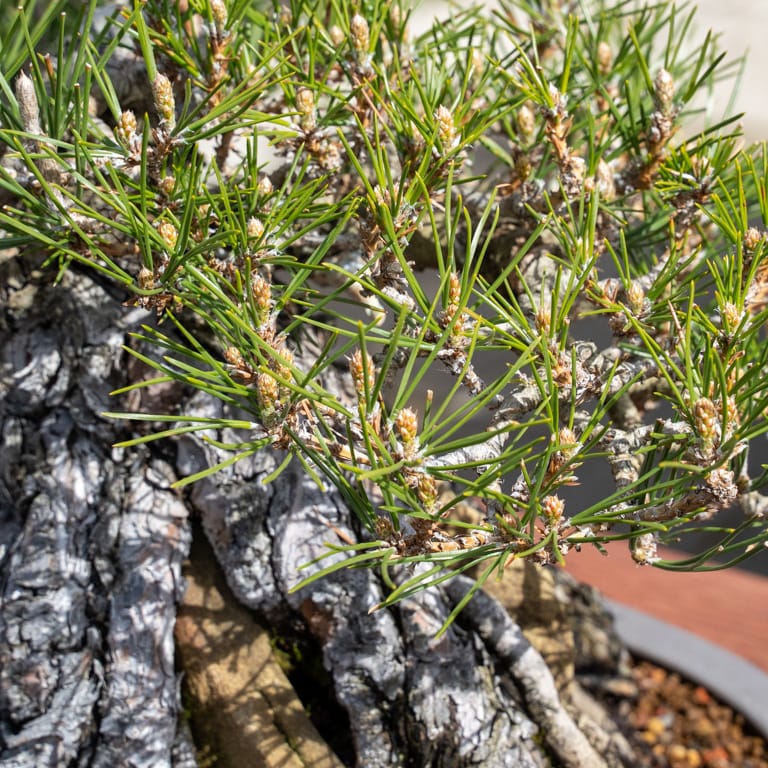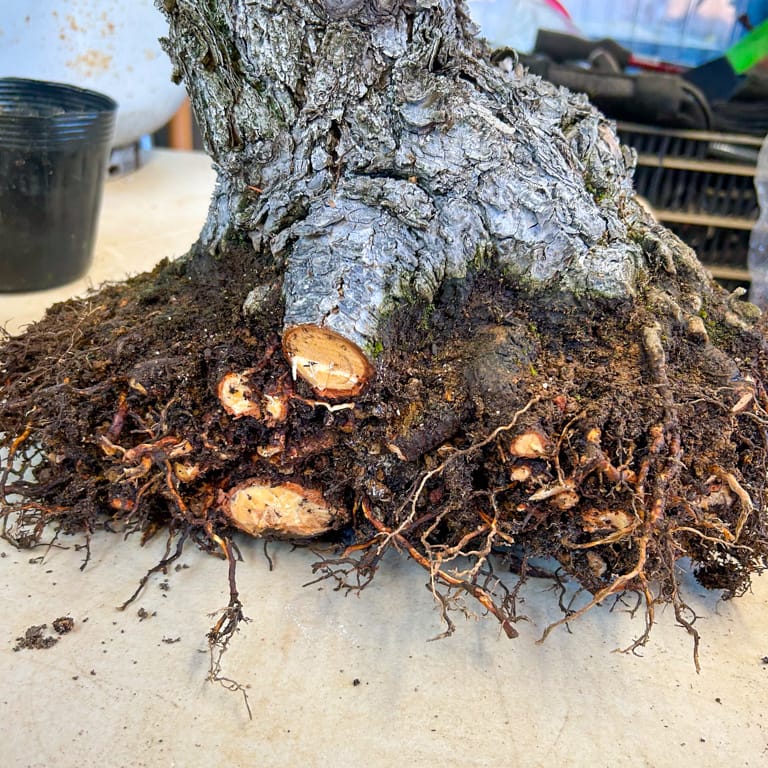This winter is turning out to be a big repotting year for me. Throughout the season, three themes are guiding the work.
1. Work in Batches
To get through as many trees as quickly as I can, I’m repotting in batches.
When the trees are young, I’ll prepare the pots, remove the trees from their containers, do the root work, and then set them all in the new containers.

Freshly repotted two-year old pines
For older trees, I’ll try to repot groups of similar species and stages of development together as I’m likely to need the same tools, containers, and soil mixes. In addition to the practical advantages, I find it easier to get into a groove and pick up on details of how similar trees grow when working this way.
2. Get the timing right
This is the first time in years I’ve been able to be strategic about when I repot. My general approach is to chip away at groups of conifers, ideally right as the buds begin to swell, and then I drop whatever I’m doing to repot deciduous trees when I see the buds start to open.

Buds starting to open on Japanese maple
The main benefit of repotting at the ideal time is that I can be more aggressive with the root work without stressing the tree as much as I would by doing the same work one month sooner (or later).
This can be challenging for anyone with lots of the same species in the garden as they tend to start growing at the same time. Because I have a lot of pines, I often repot them before I see buds swelling as I’d rather repot early than several weeks too late.

New buds on black pine – about two weeks after the ideal repotting time
3. Make big moves when necessary
Removing high percentages of soil can be stressful for any bonsai and must be done with care. That said, not removing enough old soil can prevent trees from regaining health and growing with vigor.
This year, I’m not hesitating to make big cuts when necessary or dig out pockets of old soil when I find them.

Large cuts on a field-grown black pine
Even good soil can break down and become compacted over time. For trees in the middle stages of development, I’m finding lots of opportunities to clear out such compacted soil so the tree can benefit from good soil in the core of the root ball.

Young pine after removing compacted soil
I won’t be surprised if I’ve been too aggressive on a few trees this year, but I’m curious to learn more about the exact amount of root work I can get away with and still get good growth from the tree in spring.
I’m also planning to give some of these trees a break from additional work until they’ve recovered. When I remove lots of old soil or reduce a large percentage of the root ball I make a mental note to let the tree grow freely until it’s back on track and strong enough for additional work.
That’s the goal, anyway, and I’m sticking to it as best I can this year.
Are any themes helping you get through this year’s repotting season? And for those who haven’t started repotting yet, do you have goals for what you want to accomplish when it’s time to repot? Feel free to share in the comments below.
Subscribe to Bonsai Tonight
New Posts Delivered Every Tuesday and Friday
Rsy says
Good advice Jonas😎. I’m being aggressive as well in getting old dirt or broken down akadama out and pruning big roots to give the smaller roots a chance
Dane Buxbaum says
Hi Jonas,
In Arkansas this year we had an early spring that morphed back into late winter about 2 weeks ago. This weeks lows get close to near freezing. I’d planned on a major root prune of my big crape myrtle that’s just starting to bud but am concerned that those lows might complicate the results. Typically here in Little Rock Crapes are among the later deciduous trees to wake up and can actually do well in much warmer climates.. Same goes for my Hinoke cypress, also ready for a big repot. As you probably know, this tree can withstand pretty cold temperatures and is a pure evergreen.
What are your thoughts on this choice? Wait or forge ahead now?
Thanks, big fan in Arkansas,
Dane
Jonas Dupuich says
Hi Dane! Doing the work now is fine if you can protect the trees after the repotting. If the trees will stay out on benches in near freezing weather after repotting I’d wait until you’re past the current cold. I’d definitely wait if the trees aren’t showing signs of growth yet.
bruce harris says
Japanese Black Pines do not survive well in the Dallas Texas area. Loblolly trees pines are often used as replacements to be used as pine bonsai but are not shown how to be developed as bonsai, especially because the cost because the prices involved. A six foot loblolly goes for about thirty dollars and has a trunk size of 3/4 inch. A 3 or 4 inch diameter Loblolly cost might be priced in the hundreds. I have not any Instructions on how to correctly smaller trunk tree into a growing tree into a bonsai.
Jonas Dupuich says
Hi Bruce! Good question about the Loblolly. I’ve seen some in development starting with a trunk but I haven’t seen much about growing them from scratch.
While the basics will be the same for black and loblolly pines, working with loblolly might require more aggressive techniques to keep the internodes in check.